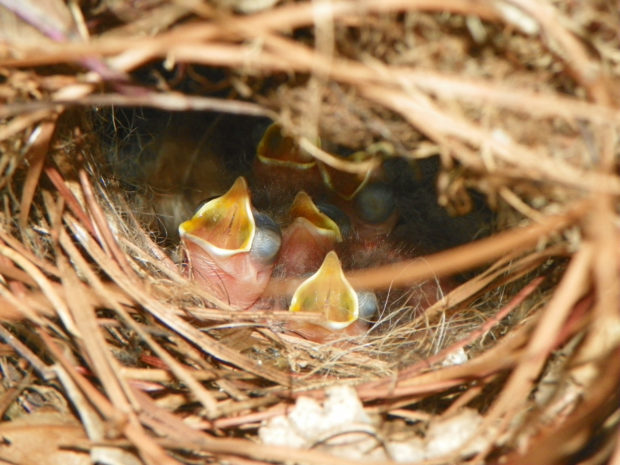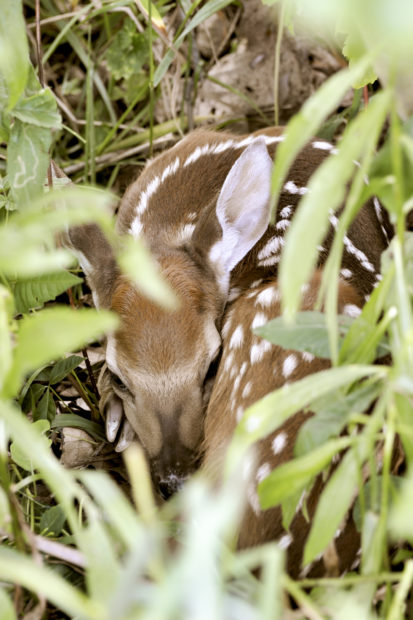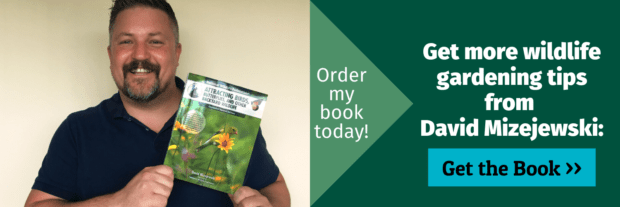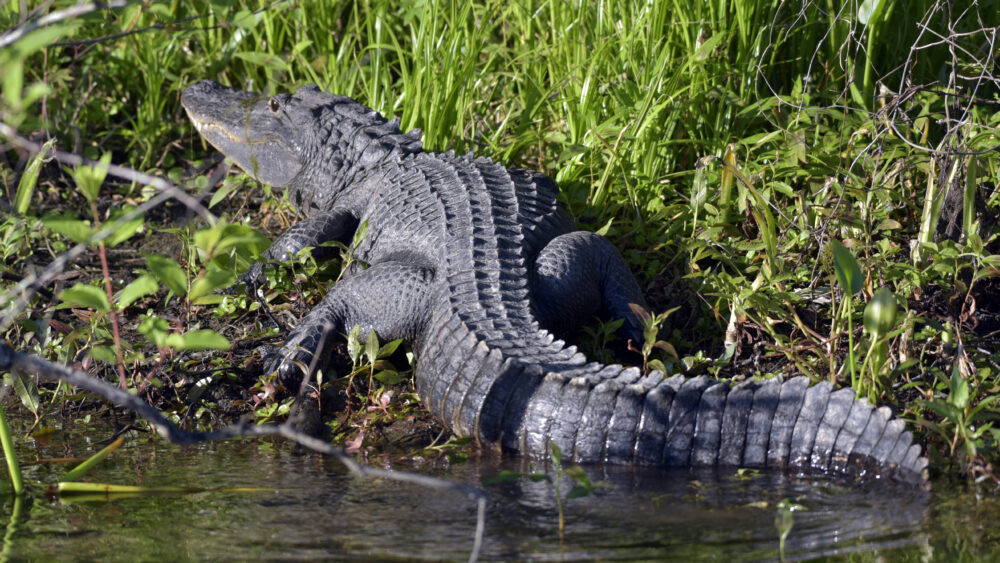We have much more to do and your continued support is needed now more than ever.
What To Do If You Find Baby Wildlife

Spring is here, and with it comes baby wildlife season. As the warm season progresses, the chance of encountering young animals from baby birds to lone deer fawns to baby squirrels in our backyards and neighborhoods increases.
What should you do–and not do–if you find a baby animal in your yard or neighborhood? Read on to find out.
Determine If the Animal Really Needs Help
When we encounter a baby wild animal, often our first instinct is to try to rescue it, especially if it’s alone. Before intervening, make sure it actually needs help. In many cases, it’s totally normal for wildlife babies to be on their own. “Rescuing” an animal that doesn’t need rescuing actually decreases its chance of survival. Though it might seem harsh, it’s normal and natural that not all wild animals survive to adulthood. Letting nature take its course is usually the best thing to do.
The exception is if an animal is injured as the direct result of human activity, such as getting hit by a car, attacked by a pet, striking a window, or falling from a nest during tree work, or if you’ve witnessed its parent being killed and know for sure that it has been orphaned. In those instances, the ethical thing to do is try to help. Calling a local wildlife rehabilitator should be your first step to provide help for the animal.
Finding a Wildlife Rehabilitator
The most important thing you can do when you find any wild animal in need, a baby or an adult, is to immediately call a local wildlife rescue center or licensed wildlife rehabilitator for assistance. If you’re unable to locate a wildlife rescue center or rehabilitator directly, contact a local animal shelter, zoo, humane society, animal control department, nature center, state wildlife agency, or veterinarian for advice. Do not try to take care of a wild animal yourself. Caring for wildlife is a round-the-clock job and requires special training to do properly. In fact, you must have a state-issued license to legally keep and care for wild animals. Unfortunately, well-meaning attempts by untrained people may result in the death of the animal.
(If you are interested in becoming a licensed wildlife rehabilitator, the Wildlife Center of Virginia’s Wildlife Care Academy is a good online course to get you started. You must be licensed in your own state.)
Species-Specific Tips
Here’s are some specific tips on some of the most commonly encountered wildlife in our yards and neighborhoods.

Birds–Baby birds are frequently encountered on the ground in spring. If the baby bird is featherless or covered in fluffy down, it is called a “nestling” and should be returned to the nest if possible. Listen and look for the parents. This can give you a good indication as to where their nest is located and where you can safely place the nestling. (Don’t be alarmed if the parents raise a fuss and dive-bomb you; they are just looking after their young!) Touching a nestling will not make the parents reject it.
If the baby bird is fully feathered, it’s called a “fledgling” and it is normal for it to be out of the nest. Fledglings spend several days on the ground hiding in the vegetation until they can fully fly. While this is a dangerous time for young birds, their parents continue to feed and protect them, and your intervention is not necessary. In fact, by taking fledglings out of the wild you decrease their chances of survival. However, if you see a fledgling in the street or otherwise in harm’s way, try to move it into dense vegetation close to where you discovered it so the parents can look after it.
Baby ducks and geese are “precocial,” meaning shortly after hatching their eyes open and they able to walk, swim and feed themselves immediately, under the watchful eye of their parents who protect them from predators. They leave the nest shortly after hatching and shouldn’t be returned to it. If you encounter a lone baby, contact a wildlife rehabilitator.

Deer and Rabbits–If you see a deer fawn lying alone in your yard or baby rabbits in a nest in your lawn, they are usually not orphaned. Mother deer and rabbits leave their young alone for most of the day to avoid attracting predators. Fawns and bunnies have fur that camouflages them and they instinctually remain still and quiet. Just observe from a distance and keep domestic animals and people away, chances are quite likely the mother will be back shortly. As with fledgling birds, “rescuing” baby deer and rabbits by removing them from the wild is unnecessary and reduces their chances of survival.
Squirrels–Squirrel mothers begin giving birth as early as late winter and can have several litters over the spring and summer. They give birth in a leafy nest built in the branches or inside tree cavities. If you find a baby squirrel on the ground with its eyes closed or that can’t move, it’s too young to be away from the mother and could be injured, dehydrated or malnourished. Contact a wildlife rehabilitator immediately and do not try to feed or raise it yourself. Baby squirrels require special care and must be fed a specific formula every few hours around the clock.
Reptiles–Baby snakes, turtles and lizards hatch from their eggs (or are born in the case of some snakes) completely equipped to care for themselves. Leave them right where they are. The best way to help them is to make sure you have plenty of native plants and other sources of cover, such as a brush or rock pile, in your yard to give them places to hide from predators.
If you unearth a nest of eggs in your yard (mulch and compost piles are favorite places for reptiles to lay eggs), leave them where they are or contact a wildlife rehabilitator for help relocating them. Embryos attach to the inside of the eggshell shortly after laying and moving the eggs could result in the death of the embryo if not done properly.
Rescuing an Animal
Rescuing any wild animal in need is best left to trained professionals. Moving wildlife is a last resort and should only be attempted if the animal is in clear and imminent danger. If there is no other choice, follow these tips:
- Wear heavy leather gloves, long pants, and long sleeves. Even small animals will bite, kick, and scratch in fear and could injure you. Gently place a towel over the animal to provide an added barrier when you pick it up. This will also minimize stress to the animal. Never attempt to capture mammals such as raccoons, foxes or bats, even their babies.
- If the animal is injured, place it in a secure container, such as a cardboard box with high sides. Close the lid or put a towel over it held in place with binder clips. Place the box in a dark, quiet place away from pets, other people, and noise. Keep the box away from direct sunlight, air conditioning, or heat, and try to avoid bringing the animal into your house.
- Do not try to feed or offer water. Injured or orphaned animals are often in shock and won’t eat or drink. Trying to make them could add additional stress or even kill them. Small animals can drown even in a shallow water dish.
- Get the animal to a licensed wildlife rehabilitator as soon as possible. Be prepared to transport the animal to the rescue facility.
- For turtles in the road, only intervene if you can do so safely. Move the turtle to the other side of the road in the direction it was heading.
- If an animal is moving erratically, approaching people without fear or foaming at the mouth, do not get near it as it could be sick and dangerous. Call animal control.
Never Try to Make Wildlife into Pets
While it may be tempting to keep wild animals as pets, especially ones you’ve helped, they are meant to live wild and free. In fact, there are laws to protect many species from being taken out of the wild by people.
Create a wildlife-friendly garden or landscapes in your own yard through our Garden for Wildlife program!
Garden for Wildlife






















